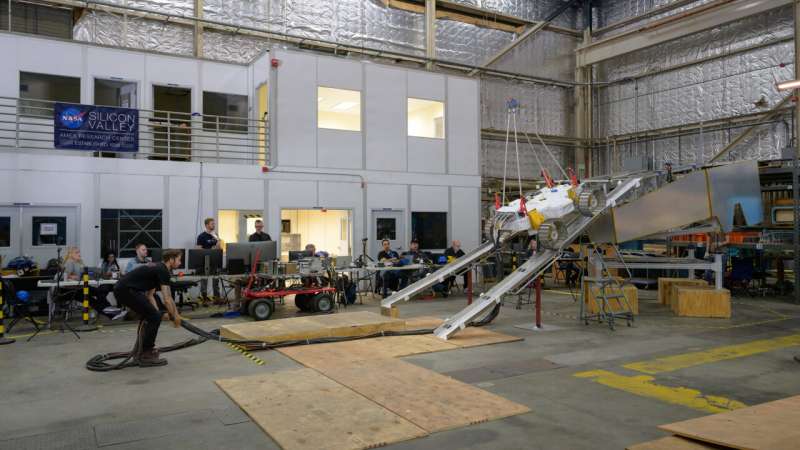NASA’s moon rover prototype conquers steep, scary lander exit test

NASA’s VIPER—short for Volatiles Investigating Polar Exploration Rover—recently completed another successful round of rigorous tests of the agency’s first robotic moon rover’s ability to drive off the Astrobotic Griffin lunar lander and onto the lunar surface. Called an egress, this hours-long operation is one of the most critical and trickiest parts of VIPER’s 100-day mission. It could be even trickier if VIPER’s off-ramps onto the moon are super steep or tilted due to uneven terrain.
Recent tests using VIPER rover and Griffin lander prototypes conducted at NASA’s Ames Research Center in California’s Silicon Valley were designed to push VIPER’s systems to the limit to ensure the rover will perform as expected during its science mission. By driving VIPER’s prototype MGRU3—which stands for the moon Gravitation Representative Unit 3—down the lander’s ramps in a series of test configurations in a facility at Ames, engineers came away with a better understanding of how the rover would perform in both normal and unusual scenarios.
Unlike big rigs that deliver cars by rolling them off standardized ramps on trailers, the geometry of the lunar lander’s ramps is designed to vary substantially, depending on what the surface is like when it arrives at its target destination atop the flat-topped lunar mountain Mons Mouton near the moon’s South Pole.
Depending on the terrain around the lander, the angle of the ramps may be especially steep, posing the risk the rover could lose traction and slip—or one ramp may be steeper than the other, requiring the VIPER real-time operations team to actively compensate for this tricky terrain.
“Through this series, we’ve tested all of the ‘bounding’ cases for VIPER’s egress on the moon,” said Jasper Wolfe, VIPER egress test lead at Ames. “This included the worst-case high-pitch scenario using the steepest—and scariest—ramps, the worst-case roll scenario using the most uneven ramps, and the worst-case scenario with pitch and roll combined.”
Seen in the photo above is a key moment of the tests, which focused on the physical interface between the rover and the lander. Critical features of the tests included software that specifically handles VIPER’s egress and changes to physical components of both the rover and the lander’s ramps. The team carefully checked to verify MGRU3 had adequate clearance and engaged the ramps correctly as it rolled from top to bottom.
“We validated these test cases with MGRU3 to be sure VIPER can do it on the moon,” said Wolfe.
Completing these tests means that VIPER should be able to successfully exit the lander even if it touches down in a tough spot—a major step forward toward flight.
“With VIPER, we’re doing a lot of firsts,” said Wolfe. “And it’s very exciting to reach this milestone.”
Citation:
NASA’s moon rover prototype conquers steep, scary lander exit test (2023, July 5)
retrieved 5 July 2023
from https://phys.org/news/2023-07-nasa-moon-rover-prototype-conquers.html
This document is subject to copyright. Apart from any fair dealing for the purpose of private study or research, no
part may be reproduced without the written permission. The content is provided for information purposes only.
For all the latest Science News Click Here
For the latest news and updates, follow us on Google News.

